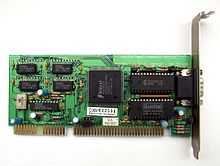Trident Microsystems
 | |
| Website | www.tridentmicro.com |
|---|---|
Trident Microsystems was a supplier of display-processors for flat panel displays (plasma, LCD, etc.), currently under Chapter 11 reorganization. At one time, Trident was also a supplier of PC graphics chipsets and sound controllers.
History
Established in 1987, Trident (along with Oak Technologies) gained a reputation for selling inexpensive (for the time) but slow SVGA chipsets. Many OEMs built add-in-boards using Trident VGA chipsets. As the PC graphics market shifted from simple framebuffer displays (basic VGA color monitor output) to more advanced hardware acceleration (multi-resolution, SVGA output; not to be confused with 3D hardware-acceleration), Trident continued its strategy of selling modestly performing chips at compelling pricepoints. In the mid-1990s, the company (briefly) caught up with its main competition: the TGUI-9680's feature-set was comparable to the S3 Graphics Trio64V+, although the Trio64V+ outperformed the 9680 in true-color mode.
The rapid introduction of 3D-graphics caught many graphics suppliers off guard, including Trident. It was not until the late 1990s that Trident finally released a competitive chip, the TGUI-9880 (Blade3D.) By this time, Trident's reach had once again retreated to the low-end OEM market, where it was crowded by ATI, S3, and SiS.
Meanwhile, in the laptop market, Trident was an early pioneer of embedded-DRAM, a semiconductor manufacturing technique which combines a graphics-controller and framebuffer-RAM on a single chip. The resulting combo-chip saved precious board-space by eliminating several RAM chips normally required for framebuffer storage.
Although Trident enjoyed some success with its 3DImage and Blade3D product-lines, the entry of Intel into PC graphics signaled the end of the bottom-end, graphics-chip market. Trident partnered with motherboard chipset suppliers several times to integrate its graphics technology into a motherboard chipset (i.e. ALi CyberALADDiN, VIA MVP4), but these achieved marginal success. Faced with a contracting market and rising research and development costs (due to the increasing sophistication of 3D-graphics rendering), Trident announced in June 2003 a substantial restructuring of the company.
In late 2003, XGI completed an acquisition of Trident's former graphics division.
In February 2010, Trident acquired the TV and STB businesses of NXP Semiconductors[1]
On January 4, 2012, Trident filed for Chapter 11 bankruptcy protection appointing Entropic Communications as the stalking horse bidder.[2]
In June 2012, Cambridge Silicon Radio paid $1M for Trident's audio products.[3]
Around the same time Sigma Designs inc purchased Trident's TV business
Graphics chipsets
The following lists are not complete.
Desktop
- TVGA 8200LX (1987)
- TVGA 8800 (1988) - first S/VGA compatible chipset (ISA), 512KB framebuffer
- 8800BR (512KB, 128KB banks only)
- 8800CS (512KB, 64KB banks + old/new mode support)
- TVGA 8900 - high-color (65,536) display-mode support, 1MB framebuffer
- 8900B (up to 1MB)
- 8900C (up to 1MB, SVGA, ISA)
- 8900CL (up to 2MB, SVGA, ISA/VLB. Slightly faster than earlier 8900 cards)
- 8900D (up to 2MB, 8900CL w/ bugs corrected)
- 8900DR (SVGA, ISA, max 1MB)
- TVGA 9000 - first integrated (VGA+RAMDAC) VGA chipset

- 9000 (low component version)
- 9000B (1992)
- 9000C (1992) - External RAMDAC
- 9000i - (rev. a/b/c, 512KB, 9000 w/ onchip 15/16bit DAC + clock gen)
- 9000i-1 (1994) - appeared on Trident's VC512TM ISA video cards
- 9100B - Slightly faster 9000
- TVGA 92xx, TVGA 938x, TVGA 94xx - first Windows accelerators
- 9200CXr
- 9380
- 9385
- 9388
- 9400CXi (max 2MB, truecolor, onchip 24bit DAC + clock gen)
- 9420DGi (PCI, 9400 w/ 2D acceleration [BitBLT, ...])
- 9430DGi (PCI, 9420 w/ hardware cursor)
- TGUI 9440 (1994) - first performance competitive Windows 2D-accelerator (2MB PCI/VLB)

- 9440AGi (PCI, 9430 w/ 16bit DAC interface + programmable clock)
- 9440-1
- 9440-3 - Unknown changes, differently designed Trident logo, rare
- 9460
- TVGA9470
- TGUI 966x - similar to 9440, 64-bit datapath
- 9660
- 9660XGi
- 968x - motion video accelerator (zoom + YUV->RGB, Directdraw overlay)

- 9680 - (64bit, 1-4MB, 9660 w/ video acceleration)
- 9680XGi
- 9682 (9680 with video in)
- 9683
- ProVidia 9685 (TV video out, UMA)

- 3DImage9750, 3DImage9850 - first Windows 3D-accelerators (4-8MB PCI/AGP)
- 3DImage 9750 (64bit, PCI/AGP, TV out)
- 3DImage 9753
- 9753WAVE (9753 + 32voice wavetable, 0.35ym, 208PQFP)
- 3DImage 9754
- 3DImage 9750DVD (9750 with DVD decoder)
- 9783
- 9785
- 3DImage 9850 (Faster 9750 core, AGP2X, AGP only)
- 3DImage 985DVD (DVD Acceleration)
- 3DImage 9850+ (Faster)
- 3DImage SME-GMA (Superscalar, Memory Enhanced, Graphics Mode Adaptability. Laptop graphics chip with 6MB embedded DRAM, smooth scaling for non-native resolutions and hardware MPEG2 decoding for DVD playback. Based on 9850+ Core.)
- Blade3D 9880 (1999) - first performance competitive Windows 3D-accelerators (8MB PCI/AGP)
- Blade3D Turbo 9880T - 135Mhz clockspeed, up from 110Mhz on the Blade 3D vanilla.
- Blade T16 9950 - little known
- Blade T64 9970 - dual-pixel quad-texture engine, AGP4X, 32MB of memory, 64-bit datapath
- Blade XP 9980 Same as T64 except 128-bit datapath, 200Mhz vs. 166Mhz
- XP4 - DirectX 8 chip.
- XP4E - AGP8x support.
- XP8 (cancelled) - DirectX 9 chip, marketed for under $100US.
- XP10 (cancelled) - PCI Express controller.
Mobile

- Cyber9320
- Cyber9382
- Cyber9385
- Cyber9397 and Cyber9397DVD
- 9525DVD
- CyberBlade
- CyberBlade Ai1
- CyberBlade e4-128
- CyberBlade i1
- CyberBlade i7
- Blade XP
- XP4
- XP4m16/XP4m32 - embedded memory.
- XP8 (cancelled) - DirectX 9 chip.
Integrated
- ALi CyberALADDiN-T ()
- ALi CyberALADDiN-P4 (CyberBLADE XP2)
- ? (codename Napa2T)
- ? (codename Napa2-P4)
- ? (codename Napa2-Banias)
Sound chipsets
- Trident 4DWAVE-DX/NX, based on the T² platform which is also used by SIS and ALi for their own audio interfaces. Supports Q3D 2.0.